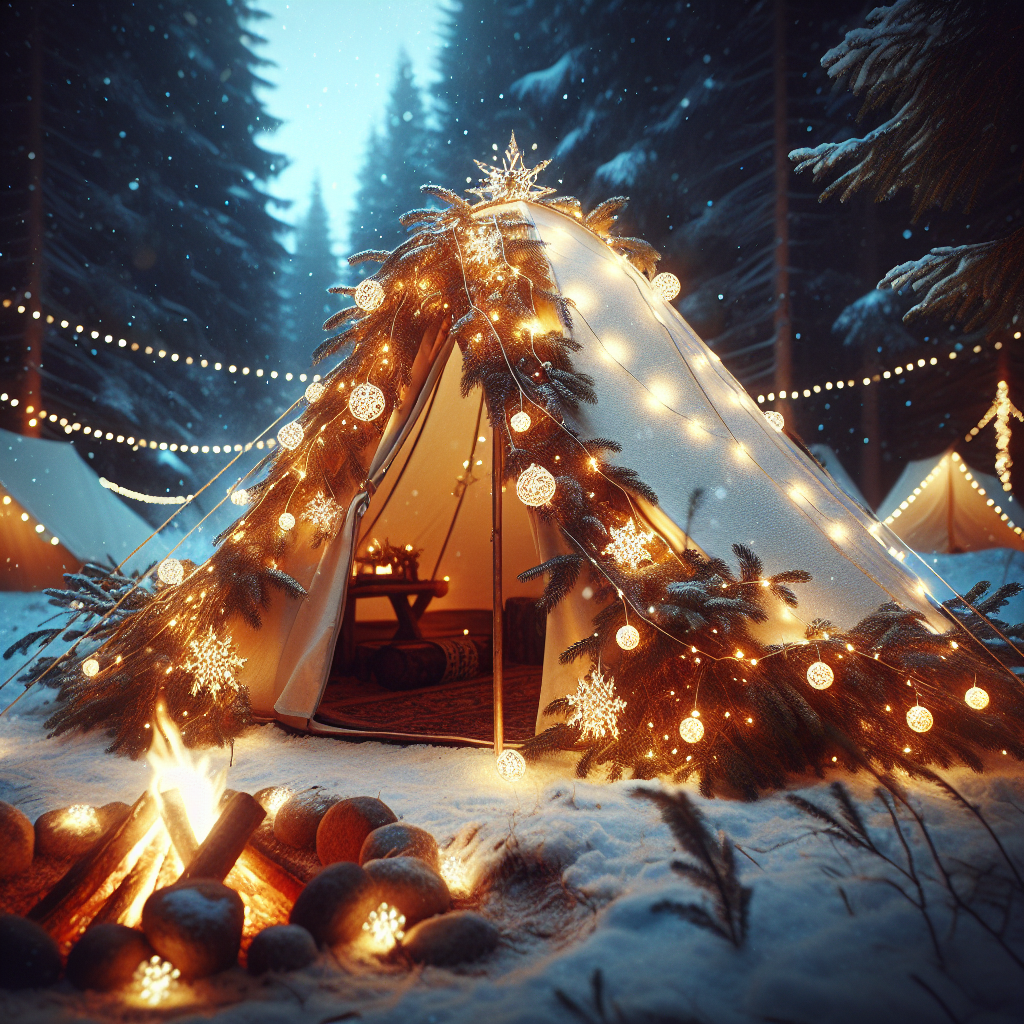As the holiday season approaches, you may find yourself looking for adventurous ways to celebrate Christmas. Camping can be a fantastic option, providing an opportunity to reconnect with nature and create lasting memories. However, camping in winter requires some additional preparation to stay warm and comfortable. That’s where sleeping bags come in. In this article, we will explore the importance of choosing the right sleeping bag for camping at Christmas, ensuring that you have a cozy and enjoyable experience amidst the winter wonderland.

The Importance of a Good Sleeping Bag for Winter Camping
When it comes to winter camping, having a good sleeping bag is essential for a comfortable and safe outdoor experience. A sleeping bag not only keeps you warm throughout the night but also provides insulation from the cold ground. It acts as a cocoon, protecting you from the harsh winter elements while you sleep. Therefore, it is crucial to choose the right sleeping bag that suits your needs and the conditions you will be camping in.
Understanding the Role of a Sleeping Bag
The primary function of a sleeping bag is to provide insulation and retain body heat, ensuring a comfortable temperature throughout the night. The insulation materials used in sleeping bags trap air, creating an insulating layer that prevents heat loss from your body. Without a proper sleeping bag, you may face the risk of hypothermia or discomfort during your winter camping adventure.
Factors to Consider During Winter Camping
When selecting a sleeping bag for winter camping, several factors should be taken into consideration. First and foremost is the temperature rating of the sleeping bag. Understanding temperature ratings is crucial to ensure that the sleeping bag can keep you warm in the specific climate and weather conditions you will encounter during your winter camping trip. Other important factors include the insulation type, materials used, size and fit, and additional features such as hoods and draft collars.
Types of Sleeping Bags for Winter
There are several types of sleeping bags available for winter camping, each with its own unique features and benefits. The most common types are mummy sleeping bags, rectangular sleeping bags, and double sleeping bags.
Mummy Sleeping Bags
Mummy sleeping bags are designed to provide maximum thermal efficiency. They are narrower at the feet and wider around the shoulders, resembling the shape of a mummy. This tapered design minimizes excess space inside the bag, reducing the amount of air that needs to be heated. Mummy bags also often come with a hood to keep your head warm. While they offer excellent insulation, some campers may find them too restrictive or claustrophobic.
Rectangular Sleeping Bags
Rectangular sleeping bags are the most common type and are often preferred for their spaciousness and versatility. They offer more room to move around and can be fully unzipped to be used as a blanket if desired. However, the rectangular shape may result in more cold air entering the bag, reducing overall insulation.
Double Sleeping Bags
Double sleeping bags are ideal for couples or those who prefer extra space. They provide ample room for two people to sleep comfortably, making them perfect for snuggling up during cold nights. Double sleeping bags often come with a detachable zipper, allowing them to be separated into two individual sleeping bags. However, they may not provide the same level of insulation as a single sleeping bag.
Temperature Ratings of Sleeping Bags
Understanding temperature ratings is crucial when choosing a sleeping bag for winter camping. Temperature ratings indicate the lowest temperature at which a sleeping bag can keep the average person warm. However, it is important to note that individual preferences and tolerance to cold may vary, so it’s always wise to choose a sleeping bag with a lower temperature rating than you expect to encounter.
Choosing a Suitable Temperature Rating for Christmas Camping
When camping during Christmas, temperatures can vary significantly depending on your location. It is essential to check the weather forecast and select a sleeping bag with a temperature rating suitable for the expected conditions. If you camp in extreme winter conditions, opt for a sleeping bag with a lower temperature rating to ensure warmth and comfort throughout the night.
The Role of Insulation in Sleeping Bags
Insulation is a key component of sleeping bags, as it determines their ability to retain heat and provide warmth in cold temperatures. Insulation materials trap air and create a barrier between the cold environment and your body. Understanding the different types of insulation used in sleeping bags is crucial when making a purchase.
Types of Insulation
The two primary types of insulation used in sleeping bags are down and synthetic. Down insulation, often made from goose or duck feathers, provides excellent warmth-to-weight ratio, compressibility, and durability. Synthetic insulation, on the other hand, is made from polyester fibers and offers better moisture resistance and insulation performance when wet.
Significance of Insulation for Winter Camping
Having proper insulation in your sleeping bag is crucial for winter camping. Insulation not only prevents heat loss but also keeps you comfortable and protected from the cold ground. Without sufficient insulation, you may experience discomfort, cold spots, and inadequate warmth during your camping trip.
How to Maintain Insulation Efficiency
To maintain the insulation efficiency of your sleeping bag, proper care is necessary. Avoid compressing your sleeping bag for extended periods as this can reduce its loft and insulation properties. Instead, store it in a loose and breathable sack when not in use. It is also important to follow the manufacturer’s instructions for washing and drying your sleeping bag to prevent damage to the insulation.
Materials of Sleeping Bags for Winter
The materials used in sleeping bags play a significant role in their overall performance, durability, and comfort. Understanding the pros and cons of different materials can help you make an informed decision when choosing a winter sleeping bag.
Popular Materials Used
Common materials used in winter sleeping bags include nylon, polyester, and ripstop fabric. Nylon is lightweight, durable, and offers excellent water resistance. Polyester is known for its moisture-wicking properties and durability. Ripstop fabric, often made from nylon or polyester, is reinforced with stronger threads to prevent tears and enhance durability.
Pros and Cons of Various Materials
Nylon is highly durable and water-resistant, making it ideal for winter camping. However, it may not provide the same level of breathability as other materials. Polyester offers better moisture-wicking capabilities and is resistant to shrinking and wrinkling. Ripstop fabric provides excellent tear resistance but may add weight to the sleeping bag.
How to Choose the Right Size & Fit
Choosing the right size and fit for your sleeping bag is important for both comfort and insulation. An ill-fitting sleeping bag can result in cold spots, reduced insulation, and discomfort during your winter camping trip.
Importance of a Proper Fit
A proper fit ensures that your sleeping bag can effectively trap and retain your body heat. Too much extra space within the bag can cause cold air to circulate, while a bag that is too tight may restrict movement and compress the insulation, reducing its effectiveness.
Factors Influencing the Choice of Size
When selecting the size of your sleeping bag, consider your height, weight, and personal preferences. Most manufacturers provide size charts to help you find the right fit. It is essential to try out the sleeping bag before purchasing to ensure it accommodates your body comfortably.
Additional Features of Sleeping Bags
In addition to insulation and materials, sleeping bags often come with various additional features that can enhance your winter camping experience.
Hood Design
Sleeping bags with hoods provide extra warmth and insulation for your head. Hoods can be tightened around the face using drawstrings, preventing heat loss from the upper body and keeping your head cozy throughout the night.
Draft Collar
A draft collar is an extra insulation layer that surrounds the neck and shoulders, preventing cold drafts from entering the sleeping bag. It helps maintain warmth inside the bag, especially during extremely cold nights.
Double Zipper
Double zippers allow for increased ventilation and temperature regulation within the sleeping bag. They enable you to unzip from the top or bottom, providing options for airflow and easy access in case you need to get in or out quickly.
Tips for Using Sleeping Bags in the Cold
Using a sleeping bag correctly in cold weather can significantly enhance your comfort and warmth during winter camping.
Zip Up Completely
To maximize heat retention, always zip up your sleeping bag completely, including the hood and draft collar. This prevents cold air from entering and ensures that your body heat stays trapped inside the bag.
Combine with a Sleeping Pad
Using a sleeping pad underneath your sleeping bag adds an extra layer of insulation between you and the cold ground. It provides cushioning, prevents heat loss, and increases overall comfort during winter camping.
Wearing Suitable Clothes Inside the Bag
Choosing the right clothing to wear inside your sleeping bag is essential for maximum warmth. Layering up with moisture-wicking base layers and thermal clothing can help maintain body heat and prevent moisture buildup, ensuring a cozy and comfortable night’s sleep.
Maintaining & Care of Sleeping Bags
Proper maintenance and care of your sleeping bag are crucial for its longevity and performance.
Cleaning and Storing
Follow the manufacturer’s instructions for cleaning your sleeping bag. Machine washing may damage delicate insulation, so hand washing is often recommended. After washing, ensure that the sleeping bag is fully dry before storage to prevent mold or mildew growth.
Repairing Tips
If your sleeping bag gets damaged, it is possible to repair minor tears or rips using a repair kit. Patching up any holes before your next camping trip will help maintain the insulation properties of the sleeping bag.
Precautions to Enhance Lifespan
To maximize the lifespan of your sleeping bag, avoid storing it in a compressed state for long periods. Always store it loosely in a breathable sack to allow the insulation to fully loft. Additionally, avoid exposing your sleeping bag to direct sunlight or extreme heat, as this can cause damage to the materials and insulation.
Best Sleeping Bags for Christmas Camping
To help you make an informed decision, here is a review of some of the top models of sleeping bags suitable for Christmas camping.
Reviewing Top Models
XYZ Sleeping Bag: This mummy style sleeping bag offers excellent insulation and is rated for extremely cold temperatures. It features high-quality down insulation and a durable nylon shell, making it perfect for winter camping.
ABC Sleeping Bag: This rectangular sleeping bag provides ample space and comfort. It has synthetic insulation, making it an ideal choice for wet or humid conditions.
Comparing Prices and Features
When comparing prices and features, consider your budget and the specific requirements of your winter camping trip. Look for sleeping bags that offer the right temperature rating, insulation type, and materials within your price range. Consider the added features that will enhance your camping experience, such as hoods and draft collars.
In conclusion, a good sleeping bag is essential for winter camping. It provides insulation, protection, and comfort during cold nights. Understanding the role of a sleeping bag, factors to consider, types of sleeping bags, temperature ratings, insulation types, material choices, size and fit, additional features, and maintenance tips are essential when choosing the right sleeping bag for your winter camping adventure. By carefully considering these factors and finding the perfect sleeping bag, you can enjoy a cozy and restful night’s sleep while exploring the winter wonderland. Happy camping!



